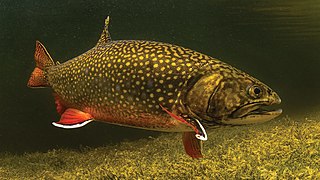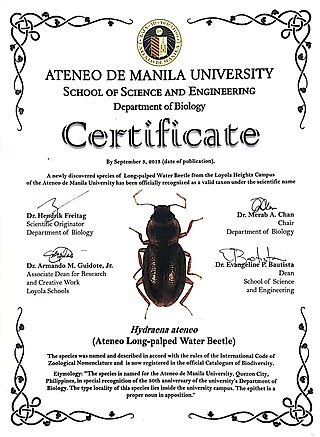
The brook trout is a species of freshwater fish in the char genus Salvelinus of the salmon family Salmonidae native to Eastern North America in the United States and Canada. Two ecological forms of brook trout have been recognized by the US Forest Service. One ecological form is short-lived potamodromous populations in Lake Superior known as coaster trout or coasters. The second ecological form is the long-living predaceous anadromous populations which are found in northern lakes and coastal rivers from Long Island to Hudson Bay, which are referred to as salters. In parts of its range, it is also known as the eastern brook trout, speckled trout, brook char, squaretail, brookie, or mud trout, among others. Adult coaster brook trout are capable of reaching sizes over 2 feet in length and weigh up to 6.8 kg (15 lb), whereas adult salters average between 6 and 15 inches in length and weigh between 0.5 and 2.3 kg. The brook trout is characterized by its distinctive olive-green body with yellow and blue-rimmed red spots, white and black edged orange fins, and dorsal vermiculation. The diet of the brook trout is restrictive to the season and location of the fish, but will typically consist of terrestrial and aquatic insects, fry, crustaceans, zooplankton, and worms.

Salvelinus is a genus of salmonid fish often called char or charr; some species are called "trout". Salvelinus is a member of the subfamily Salmoninae within the family Salmonidae. The genus has a northern circumpolar distribution, and most of its members are typically cold-water fish that primarily inhabit fresh waters. Many species also migrate to the sea.

The splake or slake is a hybrid of two fish species resulting from the crossing of a male brook trout and a female lake trout. The name itself is a portmanteau of speckled trout and lake trout, and may have been used to describe such hybrids as early as the 1880s. Hybrids of the male lake trout with the female brook trout have also been produced, but are not as successful.

Hypnum cupressiforme, the cypress-leaved plaitmoss or hypnum moss, is a common and widespread species of moss belonging to the genus Hypnum. It is found in all continents except Antarctica and occurs in a wide variety of habitats and climatic zones. It typically grows on tree trunks, logs, walls, rocks and other surfaces. It prefers acidic environments and is fairly tolerant of pollution. It was formerly used as a filling for pillows and mattresses; the association with sleep is the origin of the genus name Hypnum.

Fontinalis is a genus of submerged aquatic mosses belonging to the subclass Bryidae. These mosses are also called willow moss, fountain moss, brook moss and water moss. The genus is widespread in the Northern Hemisphere and includes both species that occur in still water and in flowing water.
Fissidens grandifrons is a moss which is the largest of the family Fissidentaceae. It is found in turbulent water which it needs to get its carbon dioxide.

Sabatinca heighwayi is a species of moth belonging to the family Micropterigidae. It was described by Alfred Philpott in 1927 and is endemic to New Zealand. It can be found north of Lewis Pass in the north west of the South Island. Adult moths are on the wing from late September until the middle of January. The host of the larvae of this species is the foliose liverwort Plagiochila circumcincta.

Hydraena ateneo is a small aquatic beetle recently discovered in Metro Manila, the Philippines. It is predominantly brown, with yellow-brown antennae. Unlike other beetles in the genus Hydraena, Hydraena ateneo can be distinguished by its small size and distinct aedeagus. The species is named after the Ateneo de Manila University, Quezon City, where the species was discovered. The species can be found in freshwater areas around Manila.

Acupalpus brunnipes is a ground beetle in the family Carabidae, found in the Palearctic, in northern and western Europe, Greece, and North Africa. It typically lives among moss and litter near water. Like most ground beetles, Acupalpus brunnipes is a predator.

Fontinalis antipyretica, greater water-moss, or common water moss, is a species of submerged aquatic moss belonging to the subclass Bryidae. It is found in both still and flowing freshwater in Europe, Asia, Greenland and Africa. In North America it is found in most Canadian provinces with a seaboard and most US states except the most southern.
Cercosaura hypnoides is a species of lizard in the family Gymnophthalmidae. It is endemic to Colombia.
Nancy Guttmann Slack was an American plant ecologist, bryologist, and historian of science. She was the president of the American Bryological and Lichenological Society from 2005 to 2007.

Fontinalis hypnoides is a species of moss belonging to the family Fontinalaceae.

Saxifraga hypnoides, called mossy saxifrage, cut-leaved saxifrage, Dovedale moss, Eve's cushion, Indian moss, lady's cushion, and queen's cushion, is a species of flowering plant in the family Saxifragaceae. It is native to northwestern Europe; Iceland, the Faroe Islands, Norway, Ireland, Great Britain, Belgium, and France, and has been introduced to Czechia, the Eastern Himalayas, and Tibet. In the north of its range a tetraploid form predominates, and in the south a diploid form is more likely to be found.
Sabatinca aurantissima is a species of moth belonging to the family Micropterigidae. This species is endemic to New Zealand and is found in the Nelson and Buller regions close to the coast and at lower altitudes. In appearance, the larvae has a distinctive pinkish-brown colour and at maturity can reach 8 mm in length. The adults are larger than many endemic species within the Sabatinca genus and have forewings that are highly reflective. These two features ensures it can be distinguished from S. aurella, a related species that is similar in appearance. The larvae feed on bryophytes.
Sabatinca bimacula is a species of moth belonging to the family Micropterigidae. This species is endemic to New Zealand and has only been found in the Percy Valley and on Secretary Island in Fiordland. This species is sexually dimorphic with the male of the species having an L-shaped marking on the forewing while in the female the L-shaped marking is much broader and takes up most of the half of the forewing nearest the abdomen. The adults of this species are on the wing in the second half of October. Larvae of this species feed on the liverwort Bazzania involuta. The host species of adult S. bimacula are unknown but are likely to be fern spores or pollen from Sedge grasses. As at 2017 S. bimacula has been classified as having the "At Risk, Naturally Uncommon" conservation status under the New Zealand Threat Classification System.

Andreaea blyttii, also commonly known as Blytt's rock moss, is a moss belonging to the family Andreaeaceae, commonly known as rock moss, granite moss, or lantern moss because of this family's unique sporangium. It is part of the genus Andreaea which is known for forming dark brownish or reddish-black carpets in high elevations. This species was first described by Schimper in 1855.
Podperaea is a genus of Asian mosses in the family Hypnaceae. It was erected by Zennosuke Iwatsuki and Janice Mildred Glime.
Podperaea krylovii is a species of moss in the genus Podperaea. Found in Asia, it was transferred to the genus Podperaea by Zennosuke Iwatsuki and Janice Mildred Glime.










